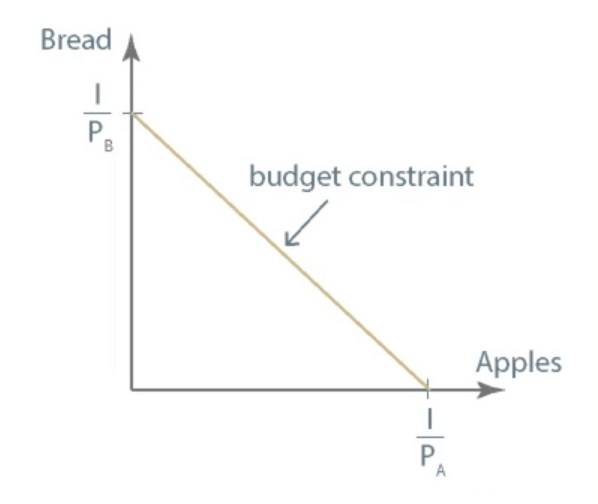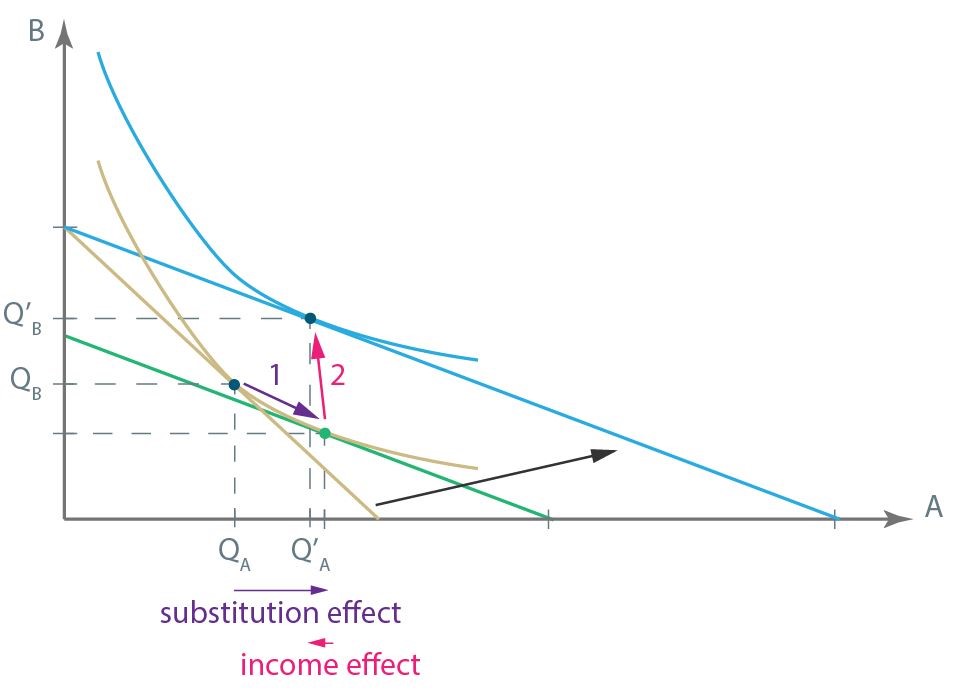Level 1 CFA® Exam:
Demand - Advanced
CFA Exam: Consumer Bundle, Indifference Curves, & Budget Constraints
star content check off when doneConsumer Bundle
A consumption bundle is a set of goods and services that consumers are willing to purchase.
Possessing a consumption bundle makes the consumer attain a certain level of satisfaction, called utility. The value of utility depends on the quantity of goods and services in a bundle. Utility theory is based on 3 axioms:
- complete preferences,
- transitive preferences,
- non-satiation.
Complete preferences means that a consumer is always able to say which of the two bundles of goods he or she prefers or treats the same. So, no two bundles that the consumer would not be able to compare exist.
Transitive preferences state that when a consumer compares any three distinct bundles A, B, and C, then if the consumer prefers A to B, and – at the same time – B to C, then the consumer must prefer A to C.
According to non-satiation, a consumer always prefers to consume more than less.
Indifference Curve
Imagine that we have only two goods available: bread (B) and apples (A). From these two goods, we can create an infinite number of bundles whose utilities depend on the quantity of each of the two goods in a bundle.
Indifference curve represents bundles that provide the same level of utility. The consumer is entirely indifferent to bundles that lie on the same indifference curve.
The shape of an indifference curve depends on consumer preferences. However, indifference curves share some common properties:
(...)
Budget Constraints
The budget constraint is a line representing the best bundles of goods that the consumer is able to purchase. So, the budget constraint is determined by consumer income and the prices of particular goods.

Note: If the prices of goods or consumer income change, the budget constraint will also change.
The change in income will result in a parallel shift of the budget constraint. If income increases, the budget constrain will shift to the right, and if income decreases, the budget constrain will shift to the left.
The change in the price of one good will cause a non-parallel shift of the budget constraint.
Choice of Bundle
(...)
If the price of one of the goods decreases, the budget constraint changes its position. As a result the consumer’s equilibrium bundle also changes. This change comes as a result of:
- the substitution effect, and
- the income effect.
The substitution effect is when a decrease in the price of a given good is accompanied by the consumer purchasing more of this good and less of the goods whose prices did not change. The substitution effect is a result of changes in the ratio of goods prices.
The income effect reflects how prices and consumer purchasing power affect the demand for a certain good. If the price of one good decreases, the real income of the consumer will increase, and it will cause changes in the demand for the goods.

Note: The substitution effect always positively affects the demand for a good: when its price drops – the demand increases.
On the other hand, the income effect may result in both increase or decrease in demand. Thus, there are 3 scenarios possible when the price of good A decreases:
- Scenario 1: A positive response to the substitution effect and a positive response to the income effect >> the demand for good A increases.
- Scenario 2: A positive response to the substitution effect and a negative response to the income effect, but less responsive than to the substitution effect >> the demand for good A increases.
- Scenario 3: A positive response to the substitution effect and a negative response to the income effect, but more responsive than to the substitution effect >> the demand for good A decreases.
Normal Goods
Scenario 1: A positive response to the substitution effect and a positive response to the income effect >> the demand for good A increases.
In Scenario 1, good A is a normal good, because the increase in income results in an increase in demand. As you probably remember, normal goods are goods whose income elasticity of demand has a positive value, which means that an increase in income is accompanied by an increase in demand for such goods.
For normal goods, the income effect is positive.
Inferior Goods
Scenario 2: A positive response to the substitution effect and a negative response to the income effect, but less responsive than to the substitution effect >> the demand for good A increases.
In Scenario 2, good A is an inferior good, because the increase in income results in a decrease in demand. Inferior goods are goods whose income elasticity of demand has a negative value, which means that an increase in income is accompanied by a decrease in demand for such goods.
For inferior goods, the income effect is negative.
Giffen Goods
Scenario 3: A positive response to the substitution effect and a negative response to the income effect, but more responsive than to the substitution effect >> the demand for good A decreases.
(...)
- A consumption bundle is a set of goods and services that consumers are willing to purchase.
- Indifference curve represents bundles that provide the same level of utility.
- The budget constraint is a line representing the best bundles of goods that the consumer is able to purchase.
- The consumer’s equilibrium bundle of goods is a basket of goods thanks to which the consumer maximizes his utility within his budget constraints.
- The substitution effect is when a decrease in the price of a given good is accompanied by the consumer purchasing more of this good and less of the goods whose prices did not change.
- The income effect reflects how prices and consumer purchasing power affect the demand for a certain good.
- The substitution effect always positively affects the demand for a good.
- For normal goods, the income effect is positive.
- For inferior goods, the income effect is negative.
- Giffen goods are characterized by a positively sloped demand curve.
- Veblen goods are goods whose rise in their prices results in higher demand.


